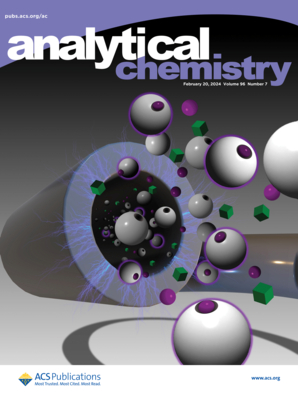Hydrogen-Bond Duality Underlying the Enthalpy Anomaly in D2O-Ethanol Mixtures.
IF 6.7
1区 化学
Q1 CHEMISTRY, ANALYTICAL
引用次数: 0
Abstract
Thermodynamic anomalies in aqueous ethanol mixtures, such as the well-known enthalpy minimum at intermediate concentrations, have long eluded a clear molecular-level explanation. Here, we employ excess Raman spectroscopy (ERS) and two-dimensional correlation Raman spectroscopy (2DCRS) to track hydrogen-bond transformations in D2O-ethanol mixtures. The spectra reveal two distinct types of hydrogen-bonding interactions formed between ethanol and water molecules near the ethanol volume fraction of 0.4, where the enthalpy minimum occurs. Density functional theory (DFT) calculations indicate that these two types of hydrogen-bond structures correspond to water-like (shorter, linear) and ethanol-like (longer, bent) interactions, respectively, and exhibit distinct electronic characters: one governed by charge-transfer (CT) interactions and the other by local excitation (LE) interactions. The stable coexistence of CT and LE type hydrogen bonds forms a highly coordinated and energetically favorable hydrogen-bonding network, providing direct microscopic insight into the enthalpic anomaly. This study establishes a combined spectroscopic-theoretical framework for resolving thermodynamic features in complex hydrogen-bonded liquids.d20 -乙醇混合物焓异常背后的氢键对偶性。
水乙醇混合物中的热力学异常,如众所周知的中间浓度下的最小焓值,长期以来一直无法在分子水平上得到明确的解释。在这里,我们使用过量拉曼光谱(ERS)和二维相关拉曼光谱(2DCRS)来跟踪d20 -乙醇混合物中的氢键转化。光谱显示,在乙醇体积分数为0.4时,乙醇和水分子之间形成了两种不同类型的氢键相互作用。密度泛函理论(DFT)计算表明,这两种类型的氢键结构分别对应于类水(较短,线性)和类乙醇(较长,弯曲)相互作用,并表现出不同的电子特征:一种由电荷转移(CT)相互作用控制,另一种由局部激发(LE)相互作用控制。CT型和LE型氢键的稳定共存形成了一个高度协调和能量有利的氢键网络,为热异常提供了直接的微观认识。本研究为解决复杂氢键液体的热力学特征建立了一个结合光谱-理论的框架。
本文章由计算机程序翻译,如有差异,请以英文原文为准。
求助全文
约1分钟内获得全文
求助全文
来源期刊

Analytical Chemistry
化学-分析化学
CiteScore
12.10
自引率
12.20%
发文量
1949
审稿时长
1.4 months
期刊介绍:
Analytical Chemistry, a peer-reviewed research journal, focuses on disseminating new and original knowledge across all branches of analytical chemistry. Fundamental articles may explore general principles of chemical measurement science and need not directly address existing or potential analytical methodology. They can be entirely theoretical or report experimental results. Contributions may cover various phases of analytical operations, including sampling, bioanalysis, electrochemistry, mass spectrometry, microscale and nanoscale systems, environmental analysis, separations, spectroscopy, chemical reactions and selectivity, instrumentation, imaging, surface analysis, and data processing. Papers discussing known analytical methods should present a significant, original application of the method, a notable improvement, or results on an important analyte.
 求助内容:
求助内容: 应助结果提醒方式:
应助结果提醒方式:


